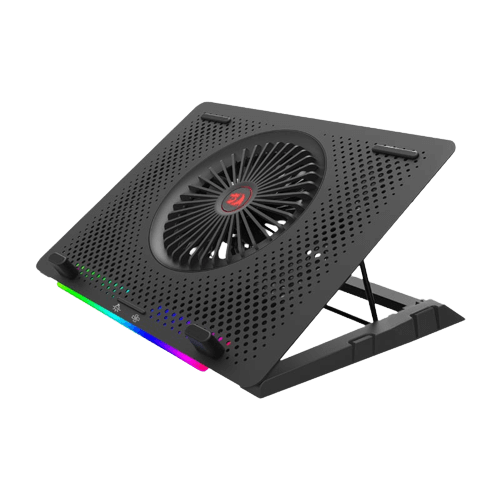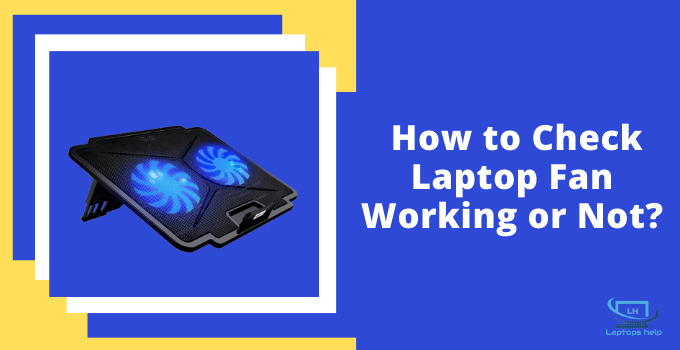The laptop fan is an important hardware component that ensures smooth functioning and operation. So it’s important to check Laptop Fan is Working or Not. The fan’s main purpose is to keep the system cool when heavy machinery operates and dissipates heat. It is important to check your laptop fan regularly to avoid damage to your laptop hardware.
Ignoring these areas puts the system at high risk and may cost more to repair. You can learn more about laptop fans and their features by reading the article below, but first of all, we have to know the Importance of Laptop Fans.
The Importance of Laptop Fans
 A laptop’s cooler fan lowers the operating temperature of the equipment, creating as much heat exposure to the equipment as possible and gradually making the equipment suitable for use.
A laptop’s cooler fan lowers the operating temperature of the equipment, creating as much heat exposure to the equipment as possible and gradually making the equipment suitable for use.
The laptop incorporates an implicit cooling fan, and a notepad cooler cushion can be used to cool the working temperature.
Delayed heat exposure and segment overheating can damage a laptop’s segments after some time, while abnormal overheating can break the operating system’s framework.
Laptops have limited space to work with for cooling, so cooling fans are fundamental to the gadget’s prosperity.
The internal laptop’s fan supports higher speeds. Still, the fan itself doesn’t make the PC faster.
PCs often use internal framework fans associated with the central and graphics processing unit heatsinks.
A fan is needed to dissipate the heat generated by these operating system pieces because it removes and cools heat from the system.
Also, read Top 10+ Best Tips on How to Speed up a Windows Laptop? in 2022.
How to Check Laptop Fan Working or Not?
Here are a few ways to check or test if your laptop fan is working properly. Stay true to this page.
1. Listening to Noise
The first way to check your laptop’s cooling system is to listen for noise. Your laptop probably has a problem if you hear loud, unpleasant noises.
However, not to be confused with moderate sound, as the cooling system of almost all laptops produces an average sound.
A way to check is to check in a quiet place with your ear down, behind the keyboard with the fan.
After doing some heavy work like multitasking, live streaming, or gaming, you’ll feel the cooling system start working to dissipate the heat.
When the fan is off, it may make a harsh thumping or screaming sound, which may cause the fan to fail.
2. Feel the Wind
If you want to check your laptop’s fan, be aware that the laptop exhaust vents may be on the left, back, or bottom.
You may have to find it anywhere; after that, you can use some paper and find it in front of your fan. Even a little bit of paper blowing can show the fan at work.
Alternatively, you can use your uncovered hand. To feel the warmth coming from the vents.
These two methods mentioned above are the simplest and most physical. You can also use other methods to check whether your laptop’s fan is working. Let’s go towards them.
3. Check for Errors
If the laptop keeps restarting without warning or consent, there is a problem. Whether the fan extinguishes the air and works to some extent has something to do with the heatsink cooling system.
It also signals a problem with the laptop’s cooling system.
4. Verification via Software
There is an application called Speed Fan designed specifically to test the cooling system of a laptop. It is a free program and can be downloaded through its website or other multiprogramming sites.
When you open the application, this is the main screen where you can see the readings taken from the current workstation. You can identify the type of GPU and CPU your PC is using.
Because many GPUs have fans based on them, that’s a decent point of view. This software can test the fan used by a specific GPU. It is also conceivable to design for specific requirements.
An essential and most important attribute of this program is the opportunity to check the temperature of almost every major part of your laptop. So download this application for fan testing.
Why does my Laptop Processor Overheat?
The laptop’s desktop has a CPU cooler consisting of a metal warming sink and a fan. The heatsink moves heat away from the processor, and the fan powers the PC’s warm ventilation through the vents.
The CPU usually overheats given that the cooling system isn’t working properly, the heat sink is never in a motionless position again, the fans stop working, or the fume vents are blocked.
Given that the heap set on the CPU is too high, the CPU can likewise overheat.
Why is the Laptop Fan Noisy?
For laptop drivers, you need to keep the drivers up to date. Outdated drivers can slow system performance and significantly affect system efficiency.
Power performance can stress the laptop fan and cause it to overheat, causing strange and loud noises.
Better air circulation keeps the surroundings healthy. This is also true for laptops. Make sure the laptop is well ventilated to avoid overheating.
Therefore, the laptop should not be placed on a lap, pillow, blanket, or similar textured surface. Placing the laptop on a hard surface with some height can provide better airflow.
Buying reliable antivirus software is a wise investment. Good quality antivirus software will protect your laptop from malware and bugs.
Protecting your system from hackers is important as they can overheat, degrade system performance, and damage your laptop fan.
Dust build-up inside the laptop reduces airflow. You may want to clean your laptop fan from time to time to keep your system running smoothly.
Another reason your laptop fan is loud could be running heavy software in the background. This issue can be resolved by closing background applications or restarting the computer.
How to keep your Laptop Fan Running Normally?
Fix Noisy Fan
Fan noise means your laptop has reached its limit. This is usually caused by a program that strains the onboard RAM.
Pay Some Attention
Unlike desktop fans, which have more room to breathe, laptop fans are smaller. So you have to blow harder to make up for it. Whatever the case, rest assured that there is a workaround for the situation.
Pick up the Laptop
Let’s start with the basics. Raising the laptop leaves room for air to circulate much more efficiently. This allows the fan to use more working space.
Most laptops have the exhaust panel partially blocked because the fan is floor-facing. This makes it difficult for hot air to escape.
So lift your laptop and give it room to breathe, and the noise will disappear soon.
Dusting Fan
If the first tip doesn’t work, you may need to clean the fan. When it comes to laptop overheating, dust build-up is nothing new.
Unfortunately, laptops are rarely maintained. So, making a significant amount of noise can clog the fan blades. Grab compressed air and blow air into the fan.
Of course, it would be better if the back panel could be removed. This will blow the dust away from the laptop and no longer get dust into the device.
In the meantime, cleaning the other internal components is a good idea. Note: Not all notebook parts are removable. Therefore, do not forcefully remove these sections.
After removing the dust, reassemble the laptop and check if the fan is still making noise.
Laptop Cooler Connection
Laptop fans can benefit a bit from external cooling fan solutions like those sold on Amazon. These devices provide additional air circulation to relieve pressure on the built-in laptop fan.
It’s affordable and detachable, so you don’t have to carry it with you when you don’t want it.
Advantages of Cooler Fans for Laptops
Laptop cooler fans lower the device’s operating temperature, limiting thermal exposure to the hardware and making the device more comfortable to use.
The laptop has a built-in cooling fan, which can be mounted on the laptop cooler pad to lower the operating temperature.
Prolonged exposure to heat and overheating components can damage computer components over time, but extreme overheating can damage your system.
Laptops have limited working space for cooling, so cooling fans are very important to the health of your device.
Faster CPU and GPU Performance
The internal laptop fan supports higher speeds. However, the fan itself doesn’t make the computer faster. Laptops often use internal system fans connected to the central and graphics processing unit heatsinks.
CPU and GPU are the biggest heat-generating components inside a laptop. It can generate enough heat to decompose on its own without cooling.
Faster computer hardware generates more heat than slower computer hardware, but both tend to break down over the same temperature range. An internal fan prevents the CPU and GPU from damaging themselves.
Low Ambient Temperature
An external cooling pad with a fan helps cool the laptop’s temperature without modifying the device’s hardware. Computer operating temperature is affected by the environment or ambient temperature.
The laptop gets hotter in a room with 100 degrees than 70 degrees. Laptops can also be affected by the air temperature that builds up around the device.
A cooling pad avoids this problem. A cooling pad uses a fan to blow cooler air into the notebook or warmer air from the notebook to lower the ambient temperature.
Ideal Resting Place
The laptop cooling pad improves laptop airflow by placing the system on a hard, flat, non-cloth surface.
Some laptops use the bottom of the unit as an air intake to cool the system, which obstructs the airflow, which is especially dangerous for the system.
Using a laptop cooling pad, you can place your laptop on a cloth surface without worrying about overheating the device.
For example, a laptop working on a wooden table will accumulate less heat than working on a thick blanket.
However, cooling pads that blow cool air into the system can push more dust into the computer when used on fabric surfaces.
More Comfortable Wrap Use
A laptop cooling fan makes using a laptop on your lap a more practical experience for both people and laptops. Although named after the lab, the lab is not ideal working conditions for a laptop.
Your knees block the vents on your laptop, the device gets hot, and a laptop without a fan gets too hot to sit comfortably on your lap.
Conclusion
If your laptop fan starts making noise, don’t panic. This source aims to provide you with the best solutions to help you overcome the problems you are facing with the performance of your laptop fans. So I hope this article is useful for you if you have any questions, then hit the comment section.
FAQs of Fan not working
How do I check if my laptop fan is working properly?
Depending on the type of laptop, you should know where the cooling fans are and where the hot air is blowing out. Up to this point, place your ear against the laptop’s body and listen to the fan. You should be able to hear it when it moves.
How can I check if the fan is working?
The easiest way to determine if a machine’s fan has stopped is to check it visually. Since it’s a desktop computer, you can usually see the fan spinning on the back of the case. If the fan does not move, it must be replaced immediately before continuing to use the product.
What should I do if my laptop fan is not working?
Capture some compressed air and run the fan with some air. Of course, it would be more convenient if you could erase the back screen. That means the stains are blown away from the laptop and no longer push dust into the device. It is recommended to clean other internal components while working.
How do I check the fan status of my computer?
To see how fast the laptop fan spins, you can open the case, go into the BIOS, or utilize a third-party application.
What if my laptop fan stops working?
This message usually appears when the laptop’s fan is not working properly, and the laptop is vulnerable to overheating. In most cases, the laptop will shut down immediately after warning of a cooling problem, rendering the laptop unusable.
When do I need to replace your laptop fan?
If the fan is dying, then you have to replace the fan. If the fan appears to be working, but the bearings inside are escaping, there may still be an issue with the rotation speed and insufficient power to cool a component or move air through the system.
Why is my laptop fan not spinning?
There are three main reasons why a CPU fan is not spinning properly. The fan may be clogged with dust, wires may become jammed in the fan, or the fan may not be getting enough energy to spin. But the possibilities and, consequently, the potential culprits are endless.
Can the laptop fan be repaired?
A failed fan should be replaced or repaired immediately because the laptop fan controls the operating temperature and directly affects the processor’s performance. A fan failure can cause the laptop to freeze or shut down and even cause more serious damage.
How much does a laptop fan repair cost?
The average cost of repairing a laptop fan is around $50 to $150, depending entirely on the laptop model, as higher laptop models may cost extra.
Are all laptop fans the same?
They don’t have to be the same model. Important specifications include diameter and width, and amount of airflow. You can get a fan if you want, assuming you can use a quieter fan with more airflow.
How long does it take to repair a laptop fan?
The procedure is less than an hour, but allocating your time and technicians may require your laptop to be in the store for several days. Longer if parts are in stock and need to be ordered.




